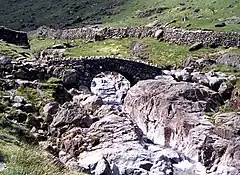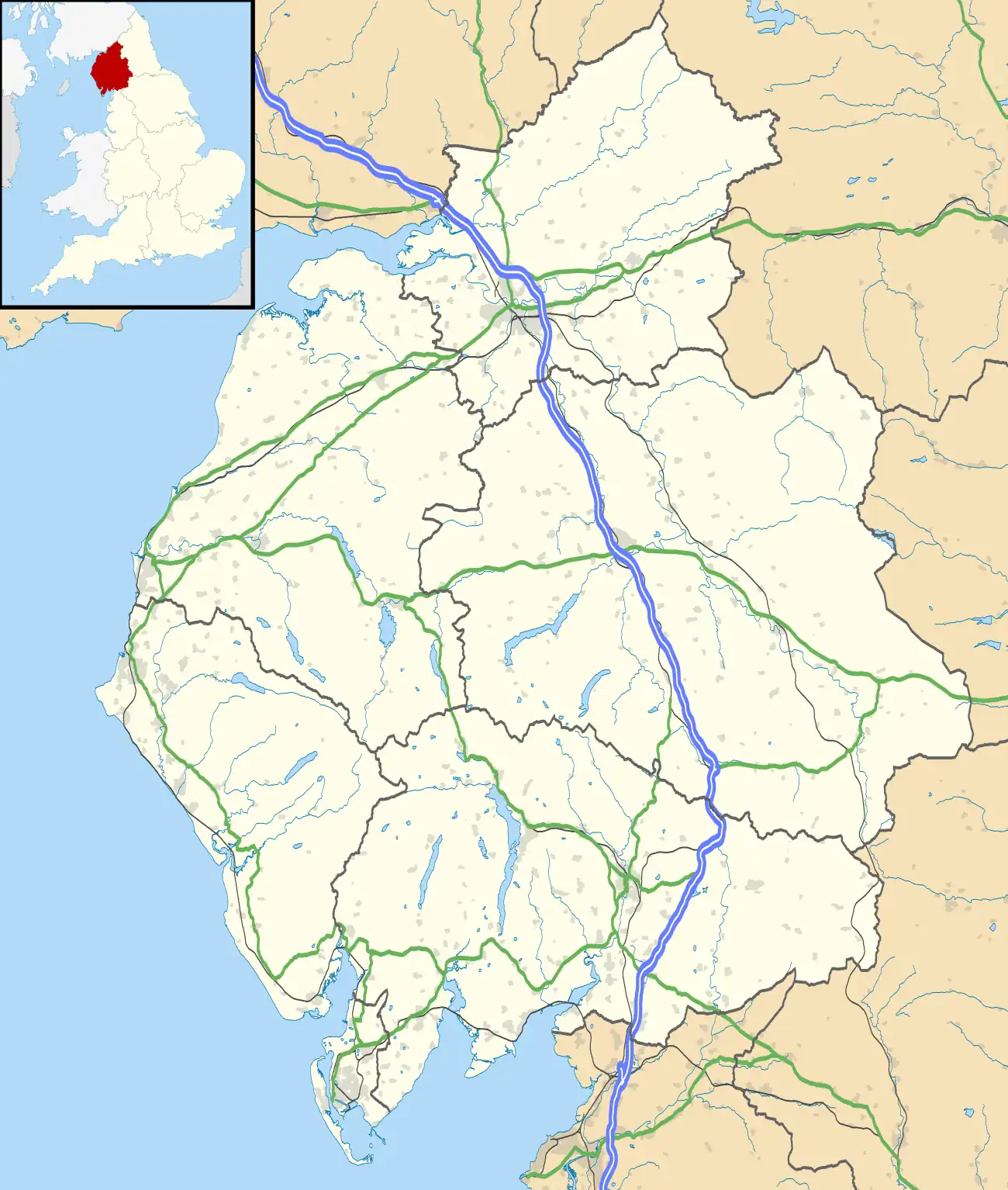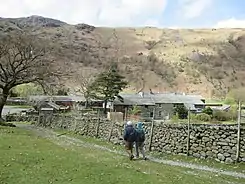| Seathwaite | |
|---|---|
 Stockley Bridge | |
 Seathwaite Location within Cumbria | |
| OS grid reference | NY233118 |
| Civil parish | |
| Unitary authority | |
| Ceremonial county | |
| Region | |
| Country | England |
| Sovereign state | United Kingdom |
| Post town | KESWICK |
| Postcode district | CA12 |
| Dialling code | 017687 |
| Police | Cumbria |
| Fire | Cumbria |
| Ambulance | North West |
| UK Parliament | |
Seathwaite is a small hamlet in the Borrowdale civil parish of Cumberland, Cumbria, North West England. It is in the Lake District near Scafell Pike and 8 miles (13 km) southwest of Keswick at the end of a minor road that heads southwest from the hamlet of Seatoller, which is where the B5289 road begins its steep climb up the pass to Honister Hause on the boundary between Borrowdale civil parish and Buttermere civil parish.[1]
The nearby Seathwaite Fell takes its name from the hamlet and lies about 1.1 miles (2 km) to the south-southwest of it. The name derives from a combination of the Old Norse words sef (sedges) and thveit (clearing) and may be taken to mean "clearing in the sedges". [2] The name, then spelled Seuthwayt, first appeared in written records in 1340. [3]
History
Along the nearby Newhouse Gill, which descends from Grey Knotts, is a graphite mine[4][5] which was opened after the discovery of graphite there in 1555.[6] The extracted graphite was eventually used to supply the Derwent Cumberland Pencil Company factory in Keswick. The commercial mining of the unusual solid form of graphite found near the hamlet of Seathwaite ceased around 1891 when veins of the solid graphite became harder to find.[7] In addition, around that time the Keswick pencil factories had switched to making pencil pigments out of the familiar combination of clay powder and graphite powder. Graphite powder could be mined and imported from elsewhere.[7] The mine entrance is north-northwest of the hamlet at 54°30′18.01″N 3°11′13.01″W / 54.5050028°N 3.1869472°W.[4][5]
For many years Seathwaite was a secluded spot, being connected to the main road at Seatoller by a rough track. However the emergence of fellwalking as an outdoor activity at the end of the 19th century led to the hamlet becoming a popular starting point for walkers bound for the surrounding mountains. The road was eventually surfaced, which led to motorists parking their cars along the verges on the approach to the farm. Seathwaite has become one of the most popular starting points for walking in the UK since it gives access to well-known mountains such as Scafell Pike, Great Gable and Glaramara. Famed Lakeland walker Alfred Wainwright made this comment:
Seathwaite, once in a little world of its own with few visitors, has become a pedestrian metropolis. Great days on the fells begin and end here.[8]
Governance
Seathwaite is within the Copeland UK Parliamentary constituency and the North West England European Parliamentary constituency. Trudy Harrison is the Member of parliament.
Before Brexit for the European Parliament its residents voted to elect MEP's for the North West England constituency.
For Local Government purposes it is in the Keswick Ward of Allerdale Borough Council and the Keswick Division of Cumbria County Council.
Climate

In 2008 Seathwaite was the wettest inhabited place in the United Kingdom and received around 3,552 millimetres (140 in) of rain per year.[1][10] In September 1966, 130 millimetres (5 in) of rain fell on Seathwaite and the surrounding fells in an hour, the resulting flood severely damaging the nearby Stockley Bridge, which lies 1,097 metres (1,200 yd) south of the hamlet. Stockley Bridge is an ancient packhorse bridge on the old route between Borrowdale and the Cumbrian coast. The bridge was widened in 1887 and had to be repaired after the 1966 storm.[11] On 19–20 November 2009 Seathwaite received 314.4 millimetres (12.38 in) of rain in a 24-hour period, a major contributor to the 2009 Cumbria and southwest Scotland floods. This was a record for the amount of rain falling anywhere in the UK within 24 hours, until it was beaten in December 2015.[12][13][14][15]
See also
Notes and references
- 1 2 The nearby uninhabited Sty Head Tarn receives 4,369 millimetres (172 in) of rain per year. Ann Bowker. "Seathwaite (Borrowdale) Cumbria the Lake District". Archived from the original on 9 April 2008. Retrieved 24 May 2008.
- ↑ Stuart Rae (cites book by Robert Gambles). "Lake District Walks and Photos". Archived from the original on 4 May 2008. Retrieved 30 May 2008.
- ↑ Gambles, Robert (1985). Lake District Place-names (2 ed.). Yorkshire: Dalesman. p. 64. ISBN 0-85206-814-X.
- 1 2 Martin and Jean Norgate, Geography Department, Portsmouth University (2008). "Old Cumbria Gazetteer, black lead mine, Seathwaite". Retrieved 19 May 2008.
{{cite web}}: CS1 maint: multiple names: authors list (link) - 1 2 Alfred Wainwright (2005). A Pictorial Guide to the Lakeland Fells, Western Fells. ISBN 0-7112-2460-9.
- ↑ Ann Bowker; Julian Thurgood & Dave Newton. "Borrowdale Cumbria and the Lake District". Archived from the original on 21 March 2008. Retrieved 24 May 2008.
- 1 2 "Industries of Cumbria – Wad". Retrieved 24 May 2008.
- ↑ "Wainwright in the Valleys of Lakeland", Alfred Wainwright, ISBN 0-7181-3481-8 Page 192 Gives information on fellwalking and quote from Wainwright.
- ↑ "Borrowdale Parish Council".
- ↑ "Lake District National Park Authority – Facts and figures". Archived from the original on 22 June 2008. Retrieved 24 May 2008.
- ↑ www.waymarking.com Gives details of Stockley Bridge.
- ↑ "Storm Desmond breaks UK rainfall record". 7 December 2015.
- ↑ "UK weather: Snow warning as Arctic blast blows in". Daily Telegraph. 25 April 2016. Retrieved 25 April 2016.
- ↑ Met Office (20 November 2009). "Recent heavy rain over north-west Britain". News Archive. Met Office. Retrieved 21 November 2009.
- ↑ Environment Agency (20 November 2009). "Environment chiefs visit flood-hit Cumbria". News, November 2009. Environment Agency. Archived from the original on 23 November 2009. Retrieved 21 November 2009.